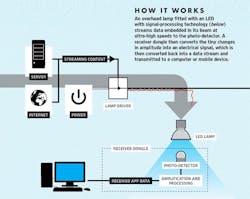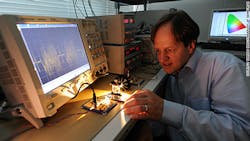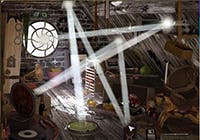On New Year’s Eve, a 19-year-old novice developer, Chase Fromm, tweeted a screenshot of iOS 9.1 firmware code that includes the text: ‘LiFiCapability.’ This has Apple devotees beaming with anticipation that their iPhone may be able to download seasons of their favorite shows in the time it takes to download a movie. LiFi, or Light Fidelity, uses LEDs to transmit up to 100 Gbps of data; the fastest WiFi, called WiGig, achieves 7 Gbps.
This fleck of code hints at what should be rather obvious: Apple has its sights on someday integrating LiFi into future products. And it would be crazy, and all together uncharacteristic, for the forward-thinking company not to take full advantage LiFi. This technology goes so beyond bleeding edge, it’s hemorrhaging edge.
“The applications of it to me are beyond imagination at the moment,” said creator Harald Haas, a professor at the University of Edinburgh 2011 who unveiled LiFi at 2011 TedTalk [video below]. “Where we have light, there is a potential way to transmit data.”
It works by fluctuating the stream of photons emitted by microchip-fitted LEDs, at speeds undetectable to the human eye. LEDs are semi-conductors, making it possible to modulate the current in this way. The receiver detects the changes in amplitude and converts them into an electrical signal. The camera sensors on a smartphone would be able to act as both the receiver and transmitter.
infographic credit: pureLiFi
LiFi has already been tested in an industrial setting in Estonia, and Haas believes it be excellent in intrinsically safe environments, such as a petrochemical plant, where RF antennas could generate a spark and possible explosion.
Projected by Haas' commercial venture pureLiFi to be a $113 billion industry by 2022, it could be the perfect data stream delivery system for large scale facilities communicate with robots, AGVs, and Internet of Things devices literally at light speed.
photo credit: University of Edinburgh/ Prof. Harald Haas models a LiFi protype.
LiFi, Haas explained, takes full advantage of the Visible Light Spectrum, which is 10,000 times wider than radio’s, which Haas says is scarce, limited, and expensive. According to Haas’ university’s website, wireless data traffic will exceed the radio frequency spectrum’s capacity by 2025. While 1.4 million RF masts in the world require energy to cool the bases, LiFi uses existing infrastructure, so it is more eco-friendly as well, Haas said.
Different lights will provide faster or slower speeds. The fastest would be a laser-based white LED using a diffuser to broaden the beam, yielding a 100 Gbps. Red, green, blue LEDs could get 5 Gbps, while phosophor coated white LEDs, commonly used in commercial lighting, delivers 100 Mbps. Because it uses line of sight to transmit, security would be enhanced, as it would be impossible to intercept the signal unless you are standing between the light source and receiver. This is also LiFi’s greatest weakness. The router wouldn’t be able to send a signal through floors and walls. This could conceivably be overcome with a system of mirrors to direct the light, a method employed in ancient Egyptian treasure chambers, Hyrulian dungeons, as well as on submarine periscopes. (Most likely, someone will come up with a better idea than this, but just in case, engineers can feel free to use this idea.)
photo source: tvtropes.com
Line of sight poses less of a problem outside, where transmitter on hillsides could beam directly to homes.
At a November TedTalk in London, Haas suggested it’s this use that may connect humanity on a scale never before seen. Using solar cells as a broadband receiver, anyone can have access to the Internet, including the 4.3 billion people who sadly don’t have access to cat memes and Candy Crush, people who think “Netflix and chill” means fishing in cold water. Once LiFi towers start dotting the horizon like futuristic inland lighthouses, the entire world, from aborigines to the Inuit, will be able to weigh in on Steven Avery’s guilt or innocence, as Haas expects to take it to market in the next two to three years.
It’s unlikely that the iPhone 7 to have LiFi, as Fromm predicted in his tweet about the iOS code. But one thing is for certain: This technology is no longer in the dark, and as Haas has said, “will lead to cleaner, greener, even brighter future.”













